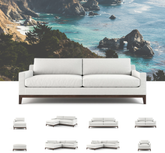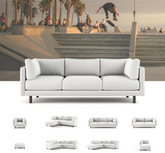

DOWN THE RABBIT HOLE
Cushion 101
Get comfy—this is where we break down the nitty-gritty of what makes a cushion truly last. From foam density to firmness, consider this your crash course in lasting comfort. Allow us to break down whats really going on in there.
What Is Foam Density?

Foam density is a fancy way of saying how much a cubic foot of foam weighs. Higher density HR Foam = better quality, better durability. At the top of the game? 2.5 pounds—premium, long-lasting, and built to handle life. Anything in the 1.8-pound range? That’s what we call a pandemic sofa—a temporary fix that’s probably already failed.
WHAT TO LOOK FOR: Want cushions that don’t give up on you after two years? Stick with 2.5-pound foam or higher. High-density HR foam will keep its shape and support for over a decade. Compare that to the 1.8 and 2.0-pound foam you’ll find in big-name retailers like PB, Crate, or those online brands (looking at you, Article, Cozy, and Interior Define).
Trust us—you’ll feel the difference.
To be clear: DENSITY ≠ FIRMNESS

Let us clear this up for you:
- Density = Quality and lifespan.
- Firmness (or ILD) = How it feels (soft, medium, or firm).
ILD (Indentation Load Deflection) measures how soft or firm the cushion feels, ranging from:
- Soft and cozy: 25 ILD
- Firm and supportive: 60 ILD
Here’s the key: A sofa can have soft cushions with 2.5-pound density or rock-hard cushions at 1.8-pound density. The difference is revealed by the ILD number—combining foam density with ILD tells the full story of comfort and support.
Foam Types:
Polyurethane Foam: The standard option, available in all levels of quality.
High-Resiliency (HR) Foam: The gold standard. Always 2.5 pounds or higher, built for comfort and durability.
Memory Foam: Great for mattresses, but a little too slow to bounce back for sofas.
Factors the Affect Longevity
USE: Heavy use compresses foam faster.
WEIGHT: Higher loads wear foam out more quickly.
CARE: Rotate cushions, keep them clean, and avoid heat or sunlight.
COVERING: Durable materials reduce wear and tear.
What About Innerspring Cushions?

We go old-school (like your parents had) with our Cali Cush and Structured Cushion, which feature innerspring seat cushions wrapped in foam and Trillium hypoallergenic fiber, a premium down alternative.Think of it like a mattress—pocketed coils surrounded by foam for support and durability, topped with a soft, cushy wrap for that cozy factor.
- Cali Cush: Medium-soft, sink-in feel.
- Structured Cushion: Medium-firm for those who like a bit more support.
Both are designed to last 13+ years without losing their shape or comfort.
Why Trillium Beats Feathers

Feathers might seem fancy, but they come with a lot of baggage. They’re great for warmth but not so great to sit on since they compress and break.Trillium, a micro-denier fiber, is a far better choice. Here’s why:
- Hypoallergenic: Feathers can trap dust mites; Trillium is clean and allergen-free.
- No Fluffing Required: Feathers need constant fluffing. Trillium holds its shape.
- No Poking or Shedding: No sharp quills or messy feathers—just pure comfort.
- Built to Last: Trillium’s synthetic fibers are durable and resilient, outlasting feathers.
- Eco-Friendly: Trillium is cruelty-free, unlike down harvested from live birds which is kinda gross to be honest.
- Consistently Comfortable: Trillium stays evenly distributed, so no lumpy cushions.
It’s why we pair Trillium with our foam in every MadeRight cushion—it’s the ultimate combination of comfort and durability.
What We Know About Other Retailers
It didn’t take much research (the online chat feature is amazing!) to figure out what some competitors use in their sofas. Here’s what we found when asking about similar-looking sofas to ours:
- Room and Board: 1.8 density foam.
- Crate & Barrel: 1.8–2.0 density foam
- Interior Define: 1.8 density foam
- Pottery Barn: 1.8 density foam
- BenchMade Modern: 2.3 density foam
- Arhaus: 2.0 density foam
Notice a pattern? Most are cutting corners with lower-density foam.


The Bottom Line
The higher the density, the longer your sofa lasts. At MadeRight, we only use high-density, high-resiliency foam because your sofa should outlast fleeting design trends, bad reality TV, and the dog who thinks it’s theirs.
If you want a sofa that stays supportive, holds its shape, and looks great for the long haul, 2.5-pound HR foam is the standard we swear by—and the only thing we’ll ever put in your sofa.
















